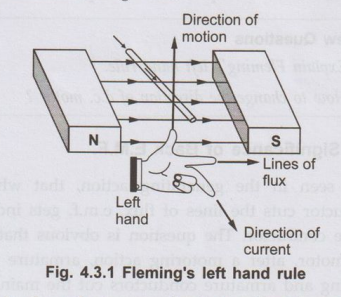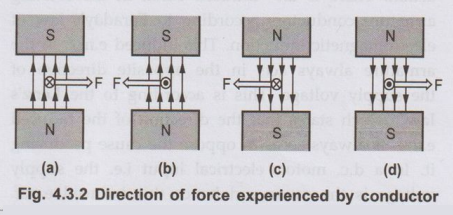Electrical Machines: Unit III: a. D.C. Motors
Direction of Rotation of Motor
Fleming's Left Hand Rule | D.C. Motors
The direction of such force i.e. the direction of rotation of a motor can be determined by Fleming's left hand rule. So Fleming's right hand rule is to determine direction of induced e.m.f. i.e. for generating action while Fleming's left hand rule is to determine direction of force experienced i.e. for motoring action.
Direction
of Rotation of Motor
•
The magnitude of the force experienced by the conductor in a motor is given by,
F
= B l I newtons (N)
B
= Flux density due to the flux produced by the field winding
l
= Active length of the conductor
I
= Magnitude of the current passing through the conductor
•
The direction of such force i.e. the direction of rotation of a motor can be
determined by Fleming's left hand rule. So Fleming's right hand rule is to
determine direction of induced e.m.f. i.e. for generating action while
Fleming's left hand rule is to determine direction of force experienced i.e.
for motoring action.
1. Fleming's Left Hand Rule
• The rule states that, 'Outstretch the three fingers of the left hand namely the first finger, middle finger and thumb such that they are mutually perpendicular to each other. Now point the first finger in the direction of magnetic field and the middle finger in the direction of the current then the thumb gives the direction of the force experienced by the conductor'.
•
The Fleming's left hand rule can be diagramatically shown as in the Fig 4.3.1

•
Apply the rule to crosscheck the direction of force perienced by 2 single
conductor placed in the magnetic filed, shown in the Fig.4.3.2 (a),(b),(c) and
(d)

•
It can be seen from the Fig. 4.3.2 that if the direction of the main field in
which current carrying conductor is placed, is reversed, force experienced by
the conductor reverses its direction. Similarly keeping main flux direction
unchanged, the direction of current passing through the conductor is reversed,
the force experienced by the conductor reverses its direction. However if both
the directions are reversed, the direction of the force experienced remains the
same.
Key Point:
So in a practical motor, to reverse its direction of rotation, either direction
of main field produced by the field winding is reversed or direction of the
current passing through the armature is reversed.
•
The direction of the main field can be reversed by changing the direction of
current passing through the field winding, which is possible by interchanging
the polarities of supply which is given to the field winding. In short, to have
a motoring action two fluxes must exist, the interaction of which produces a
torque.
Review Questions
1. Explain Fleming's
left hand rule.
2. How to change the
direction of d.c. motor?
Electrical Machines: Unit III: a. D.C. Motors : Tag: : Fleming's Left Hand Rule | D.C. Motors - Direction of Rotation of Motor
Related Topics
Related Subjects
Electrical Machines I
EE3303 EM 1 3rd Semester EEE Dept | 2021 Regulation | 3rd Semester EEE Dept 2021 Regulation
